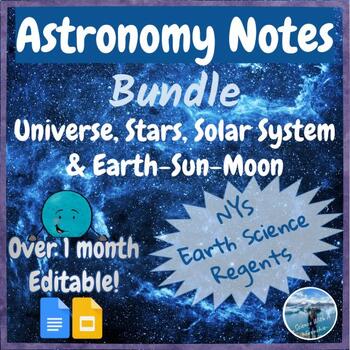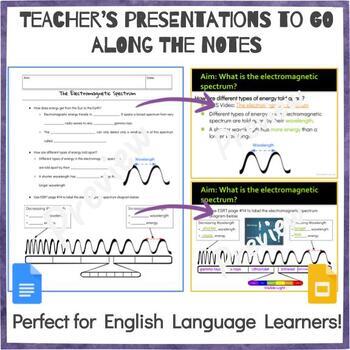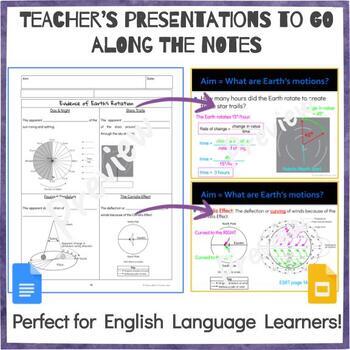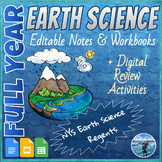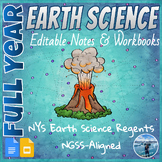Astronomy Notes for NYS Earth Science Regents | Editable
- Zip
- Google Apps™

Products in this Bundle (3)
Also included in
- This growing bundle includes everything your students need to know for the New York State (NYS) Regents Earth Science course.⭐ Save 20% ⭐This bundle includes 11 earth and space science notes and workbooks with associated digital review activities for the NYS ESRT, which are part of the explain and ePrice $181.60Original Price $227.00Save $45.40
- This growing bundle includes everything your students need to know for the New York State (NYS) Earth Science Regents course.⭐ Save 20% ⭐This bundle includes 12 units of earth and space science notes and workbooks. These notes can be used as standalone or as part of the explain and elaborate phasesPrice $133.60Original Price $167.00Save $33.40
Description
This complete astronomy bundle covers everything your students need to know about the Universe, Stars, the Solar System, and the Earth-Sun-Moon System for the New York State (NYS) Regents exam. It includes guided notes with practice questions and annotated teacher presentations in Google Slides. The students will learn about the electromagnetic spectrum, evidence for the Big Bang theory, the star HR diagram, the life cycle of stars, terrestrial vs. jovian planets, planetary orbits, the seasons & insolation, the Sun's paths in the sky, evidence for rotation and revolution, the phases of the Moon, tides, and eclipses. They will also learn how to read and use pages 14 and 15 of the Earth Science References Tables (ESRT) as well as practice answering Regents questions.
⭐ Save 20% ⭐
What's included?
- Universe & Stars Notes and Workbooks | Editable
- Student Guided Notes & Workbook: 26 pages of notes with practice questions to share with your students (printed or digital).
- Teacher Presentations: 99 annotated and animated Google Slides™ that go along the workbook.
- Teacher Notes: 4 pages with a pacing guide.
- The Solar System Notes and Workbooks | Editable
- Student Guided Notes & Workbook: 18 pages of notes with practice questions to share with your students (printed or digital).
- Teacher Presentations: 62 annotated and animated Google Slides™ that go along the workbook.
- Teacher Notes: 4 pages with a pacing guide.
- The Earth-Sun-Moon System Notes and Workbook | Editable
- Student Guided Notes & Workbook: 40 pages of notes with practice questions to share with your students (printed or digital).
- Teacher Presentations: 157 annotated and animated Google Slides™ that go along the workbook.
- Teacher Notes: 5 pages with a pacing guide.
What students do:
- Thermal Energy Transfers:
- Explain the three types of energy transfers: radiation, convection, and conduction.
- The Electromagnetic Spectrum:
- Use page 14 of the ESRT to infer the wavelengths of different types of energy found in the Universe.
- Differentiate between the different types of energy.
- The Universe & the Big Bang Theory:
- Summarize the theory of the Big Bang.
- Know the approximate age of the universe.
- Explain the three pieces of evidence for the Big Bang theory:
- Evidence #1 – The Doppler Effect (REDSHIFT)
- Evidence #2 - Cosmic Background Radiation
- Evidence #3 – Composition of the Matter in the Universe
- Characteristics & Life Cycle of Stars:
- Describe star luminosity.
- Describe the Hertzsprung-Russell (HR) diagram on page # 15 of the ESRT.
- Use the HR diagram to describe star characteristics.
- Describe main sequence stars and those that do not fall along the main sequence.
- The Solar System / Terrestrial vs. Jovian Planets:
- Describe planets, moons, asteroids, comets, and meteors.
- Explain the similarities and differences between terrestrial and jovian planets.
- Read and interpret the Solar System Data chart on ESRT page #15.
- Define the heliocentric and geocentric models of the solar system.
- Planetary Orbits & Eccentricity:
- Create models of planetary orbits
- Calculate the eccentricity values of planetary orbits by using the eccentricity formula on page #1 of the ESRT.
- Compare the eccentricity values of planetary orbits.
- Gravitational Influences:
- Explain how gravity influences the behavior of objects in orbit.
- Explain how the speed of a celestial object in orbit changes as it revolves around the Sun.
- The Seasons:
- Explain the two factors that cause the seasons: Earth’s revolution around the sun and the tilt of the Earth.
- Define equinox.
- Model the position of the Earth during the four seasons.
- Predict how much insolation the Equator, the tropics, the poles, and New York have at the different positions on the orbit.
- Sun’s Paths in the Sky:
- Model the apparent motions of the sun throughout the year.
- Predict the position of the sun in the sky for different months of the year.
- Predict the appearance and direction of shadows at different times of the day.
- Earth’s Motions:
- Explain Earth’s motions: rotation and revolution.
- Provide evidence of Earth’s rotation.
- Provide evidence of Earth’s revolution.
- The Phases of the Moon:
- Explain that the Moon’s cycle of phases is a cyclic event.
- Describe the Moon’s cycle of phases.
- Locate the position of the Sun, Moon, and Earth at each lunar phase.
- The Tides:
- Explain the forces that cause and affect tides.
- Analyze tidal change graphs and data.
- Forecast future high and low tide events.
- Compare spring tides and neap tides.
- Solar & Lunar Eclipses:
- Distinguish between lunar and solar eclipses.
- Model how lunar and solar eclipses occur.
- Predict when an eclipse is most likely to occur.
ESL Strategies:
- The guided notes are scaffolded for English Language Learners (ELLs). They contain many visuals and include minimal note-taking to allow more time to practice questions.
- Most videos are available in English and Spanish or you can change the subtitles to other languages.
Editable: You can edit all the Google Docs™ and Google Slides™.
⭐ My store is new, follow me for notifications about new resources coming soon!
Thanks for looking!

